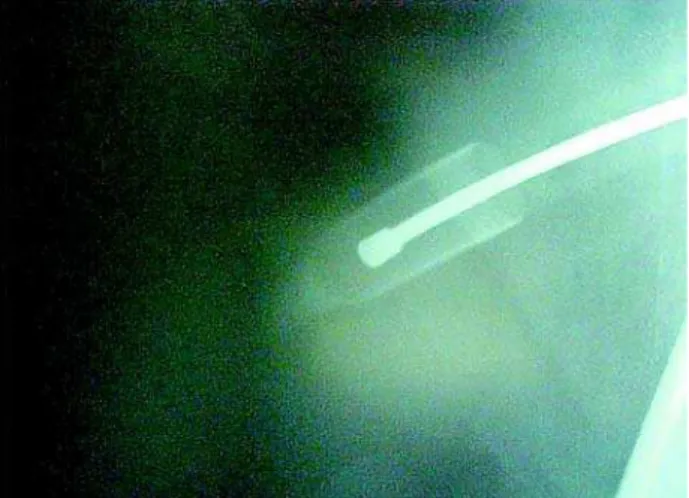74
Bovine Pericardium In Penile Prosthesis Case Report
International Braz J Urol Vol. 33 (1): 74-76, January - February, 2007
Bovine Pericardium In Penile Prosthesis Reimplantation
Eduardo J. Lopes, Tarsila C. Santos, Modesto Jacobino
Section of Urology, University Hospital, Federal University of Bahia, Salvador, Bahia, Brazil
ABSTRACT
We present a case of a patient who underwent a late penile prosthesis implant using bovine pericardium as a complement to the tunica albuginea involved in intense fibrosis that destroyed the corpus cavernosum after an infectious manifestation. The advantages of using bovine pericardium in the substitution of the tunica albuginea are discussed and its first use as a penile prosthesis lining is reported.
Key words: penile prosthesis; infection; graft; pericardium; cattle
Int Braz J Urol. 2007; 33: 74-6
INTRODUCTION
The incidence of infection in penile prosthe-sis implant surgery is approximately 3% (1,2). With this low percentage, the late implant is the most adopted option, and, eventually, the intense fibrosis that involves the corpora cavernosa makes the re-im-plantation of a new prosthesis more difficult (1,2).
The authors report a case of a diabetic pa-tient who presented extrusion of the prosthesis through the gland. Conservative treatment was ini-tially adopted, followed by a late implant that required a reconstruction of the tunica albuginea with biologi-cal material.
CASE REPORT
A 62-year-old diabetic patient with a penile prosthesis implant presenting a perforation of the gland and partial extrusion of the prosthesis that had been implanted 3 years before was attended in
emer-gency. As the right unit of the prosthesis perforated the gland and was partially extruded, its removal was achieved through the extrusion location. The left unit was removed through the same orifice after verifica-tion that both units were occupying the same space due to a complete destruction of the intercavernous septum. The material was collected for culture and antibiotic therapy with cephalosporin and aminoglycoside was begun. Following this, the space was cleansed with 0.9 % physiological saline con-taining gentamicin. A suture of the corpus cavernosum was performed using vycril 2-0 and the orifice of the glandar corpus spongiosum was sutured with chrome-catgut 3-0 in 2 simple stitches. The result of the cul-ture revealed the presence of Staphylococcus aureus and Streptococus epidermidis sensitive to the adopted antibiotic therapy.
75
Bovine Pericardium In Penile Prosthesis
for 48 h), metronidazol (400 mg IV of 8 every 8 h for 48 h), and gentamicin sulfate (160 mg in physiologi-cal saline solution) where the prosthesis was sub-mersed. Due to the intense fibrosis and the small space within the tunica albuginea, it was only possible to implant a single unit. We opted for the inverted inser-tion of the prosthesis in the distal extremity of the tunica albuginea using the small space inside the cor-pus cavernosum (Figures-1 and 2). The 4 mm bovine pericardium was used to line the entire extension of the implanted prosthesis, complementing the fibrosed tunica albuginea (Figure-3). Two years later, the pa-tient is satisfied with the result and has been main-taining regular sexual relations without any com-plaints or recurrences.
COMMENTS
When infection occurs in a penile prosthe-sis implant, 2 procedures can be adopted: 1) a res-cue procedure, which requires an exhaustive cleans-ing of the area, antibiotic therapy and the re-implan-tation of a new prosthesis at the same time (this is considered an exception despite the good result ob-tained by some authors (2); and 2) late implant, ne-cessitating removal of the prosthesis, local cleans-ing, specific treatment for the infection and implant of a new prosthesis following remission of the in-fection (2).
We chose the second option because of our greater experience with it and because this procedure is more discussed and accepted. The period between the removal of the prosthesis and the implant re-mains uncertain, varying from 2 to 39 months (with a mean of 8 months) (1,2). In this case, we opted for the implant of a new prosthesis 2 months after the first intervention.
Even though synthetic materials are avail-able and inactive, they have the disadvantage of pre-senting a larger rate of infection, inelasticity and fi-brosis of the corpora cavernosa (1,2). On the other hand, the tensional strength of the biological mate-rial has been questioned, this matemate-rial is not readily available and has a larger risk of diseases transmis-sion (1).
Figure 1 – Rx showing a single prosthesis implanted in an inverted fashion.
Figure 2 – AMS 650 prosthesis with the inferior extremity inserted in the gland.
76
Bovine Pericardium In Penile Prosthesis
We have chosen bovine pericardium because of its lower cost, inertia, elasticity, absence of trans-mission of diseases, low probability of retraction and good resistance to tension that allow it to cover large defects without forming protuberances (3). Despite having never been used as a lining for a penile pros-thesis, we believe that it is another option in extreme situations such as the one we are describing.
CONFLICT OF INTEREST
None declared.
REFERENCES
1. Palese MA, Burnett AL: Corporoplasty using pericar-dium allograft (tutoplasty) with complex penile pros-thesis surgery. Urology. 2001; 58: 1049-52.
2. Mulcahy JJ, Brant MD, Ludlow JK: Management of infected penile implants. Tech Urol. 1995; 1: 115-9. 3. Pomerantzeff PM, Zerbini EJ, Verginelli G, Jatene AD:
Valve replacement in the Heart Institute, University of Sao Paulo, Brazil. Ann Thorac Surg. 1989; 48: S41-4.
Accepted after revision: July 29, 2006
Correspondence address:
Dr. Eduardo José Andrade Lopes Rua Altino Serberto de Barros, 241 / 405 Ed. Memorial Itaigara
Salvador, BA, 41850-010, Brazil Fax: + 55 71 3351-7424
